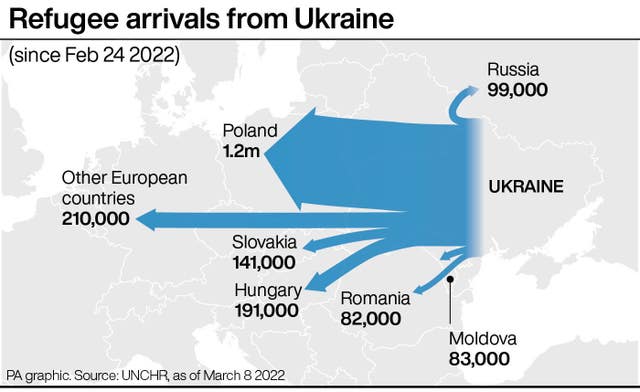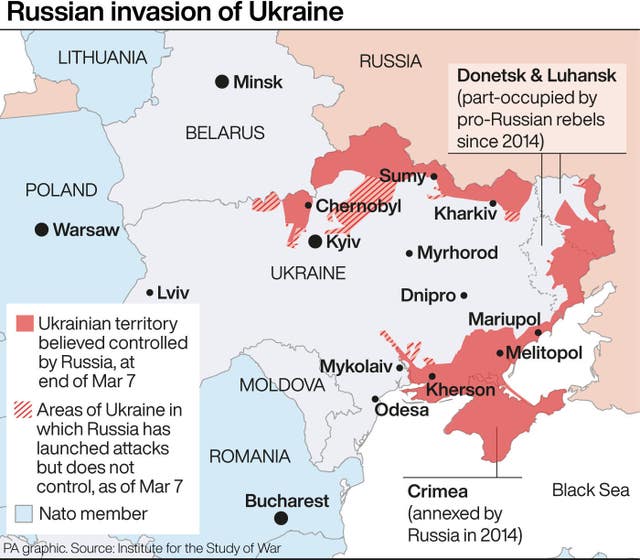
Ian Payne 4am - 7am
9 March 2022, 14:54

Ukrainian President Volodymyr Zelensky said efforts were under way to evacuate some 18,000 people from Kyiv and embattled towns near it.
Renewed efforts to evacuate civilians from besieged and bombarded Ukrainian cities are underway as authorities seek to rescue people from increasingly dire conditions.
Days of shelling have largely cut residents of the southern city of Mariupol off from the outside world and forced them to scavenge for food and water.
Authorities announced another cease-fire to allow civilians to escape from Mariupol and Sumy in the northeast, Enerhodar in the south, Volnovakha in the southeast, Izyum in the east, and several towns in the region around the capital Kyiv.
Previous attempts to establish safe evacuation corridors have largely failed due to attacks by Russian forces, and there were few details on Wednesday’s new effort. But air raid sirens repeatedly went off in the capital and explosions could be heard there, raising tensions in the rattled city.

Mariupol, which nearly half of the population of 430,000 is hoping to flee, has been surrounded by Russian forces for days. Corpses lie in the streets and people break into shops in search of food and melt snow for water. Thousands huddle in basements, sheltering from the Russian shells pounding this strategic port on the Azov Sea.
“Why shouldn’t I cry?” resident Goma Janna demanded as she wept by the light of an oil lamp below ground, surrounded by women and children. “I want my home, I want my job. I’m so sad about people and about the city, the children.”
Thousands of people are thought to have been killed, both civilians and soldiers, in two weeks of fighting since President Vladimir Putin’s forces invaded. The UN estimates that more than two million people have fled the country, the biggest exodus of refugees in Europe since the end of the Second World War.
The crisis is likely to get worse as Russian forces step up their bombardment of cities throughout the country in response to stronger-than-expected resistance from Ukrainian forces. Russian losses have been “far in excess” of what Mr Putin and his generals expected, CIA director William Burns said on Tuesday.
An intensified push by Russian forces could mean “an ugly next few weeks,” Mr Burns told a congressional committee, warning that Mr Putin was likely to “grind down the Ukrainian military with no regard for civilian casualties”.
Britain’s Ministry of Defence said on Wednesday that fighting continues northwest of Kyiv. The cities of Kharkiv, Chernihiv, Sumy and Mariupol are being heavily shelled and remain encircled by Russian forces.

Russian forces are placing military equipment on farms and amid residential buildings in the northern city of Chernihiv, Ukraine’s general staff said. In the south, Russians dressed in civilian clothes are advancing on the city of Mykolaiv, a Black Sea shipbuilding centre of a half-million people, it said.
The Ukrainian military, meanwhile, is building up defences in cities in the north, south and east, and forces around Kyiv are “holding the line” against the Russian offensive.
That resistance is stiffer than many expected — and Western nations are rushing now to bolster their force. Ukraine’s president has pleaded repeatedly for warplanes to counter Russia’s significant air power, though Western countries have disagreed over how best to do that amid concerns it could raise the risk of the war expanding beyond Ukraine.
Poland late on Tuesday offered to give the US 28 MiG-29 fighter planes for Ukraine’s use. US officials said that proposal was “untenable” but they would continue to consult with Poland and other Nato allies.
In addition to material support for Ukraine, Western countries have sought to pressure Russia through a series of punishing sanctions. On Tuesday, President Joe Biden upped the ante further, saying said the US would ban all Russian oil imports, even if it meant rising costs for Americans.
Energy exports have kept a steady stream of cash flowing to Russia despite otherwise severe restrictions that have largely cut its economy off from the world. McDonald’s, Starbucks, Coca-Cola, Pepsi and General Electric all announced that they’re temporarily suspending business in the country, furthering that isolation.
The moves have done little to blunt the conflict so far.

A series of air raid alerts on Wednesday morning urged residents of the capital to go to bomb shelters amid fears of incoming missiles. Associated Press reporters later heard explosions.
Such alerts are common, though irregular, keeping people on edge. Kyiv has been relatively quiet in recent days, though Russian artillery has pounded the outskirts of the city.
On those outskirts, police officers and soldiers helped elderly residents from their homes on Tuesday. People crowded together under a destroyed bridge before crossing a river on slippery wooden boards as they tried to escape Irpin, a town of 60,000 that has been targeted by Russian shelling.
Kyiv regional administration head Oleksiy Kuleba said the crisis for civilians was growing in the capital, with the situation particularly critical in the city’s suburbs.
“Russia is artificially creating a humanitarian crisis in the Kyiv region, frustrating the evacuation of people and continuing shelling and bombing small communities,” he said.
Amid the bombardments, authorities have tried repeatedly to evacuate civilians, but many attempts have been thwarted by Russian shelling.
One evacuation did appear successful on Tuesday, with Ukrainian authorities saying 5,000 civilians, including 1,700 foreign students, had managed to escape from Sumy, an embattled northeastern city of 250,000 people.

That corridor was to reopen for 12 hours on Wednesday, with the buses that took people southwest to the city of Poltava the day before returning to pick up more refugees, regional administration chief Dmytro Zhyvytskyy said.
Priority was being given to pregnant women, women with children, the elderly and the disabled.
In the south, Russian troops have advanced deep along Ukraine’s coastline in an effort to establish a land bridge to Crimea, which Moscow seized from Ukraine in 2014.
That has left Mariupol encircled by Russian forces.
On Tuesday, an attempt to evacuate civilians and deliver badly needed food, water and medicine failed, with Ukrainian officials saying Russian forces fired on the convoy before it reached the city.
Natalia Mudrenko, a senior member of Ukraine’s UN Mission, told the Security Council that the people of Mariupol have “been effectively taken hostage” by the siege. Her voice shook with emotion as she described how a six-year-old died shortly after her mother was killed by Russian shelling. “She was alone in the last moments of her life,” she said.

Theft has become widespread in the city as beleaguered residents search for food, clothes, even furniture. Some residents are reduced to scooping water from streams. Authorities say they plan to start digging mass graves for the dead.
With the electricity out, many people rely on their car radios for information, picking up news from stations broadcast from areas controlled by Russian forces or Russian-backed separatists.
Ludmila Amelkina, who was walking along an alley strewn with rubble and walls pocked by gunfire, said the destruction had been devastating.
“We don’t have electricity, we don’t have anything to eat, we don’t have medicine. We’ve got nothing,” she said, looking skyward.
City authorities in Mariupol are burying their dead in a mass grave.
With the city under steady bombardment, officials had been waiting for a chance to allow individual burials to resume. But with morgues overflowing and many corpses uncollected at home, they decided they had to take action.
A deep trench some 25 metres long was opened in one of the city’s old cemeteries in the heart of the city. Social workers brought 30 bodies wrapped in carpets or bags on Wednesday, and 40 were brought on Tuesday. Other city workers are also bringing bodies so the numbers being buried are quickly rising and the total in the long grave is now unclear.
The dead include civilian victims of shelling on the city as well as some soldiers. Workers with the municipal social services have also been collecting bodies from homes, including some civilians who died of disease or natural causes.
No mourners were present. No families said their goodbyes. Workers quickly made the sign of the cross after pushing the bodies into the common grave.
The work was carried out efficiently and unceremoniously as a result of the ever-present danger. Shells landed in the cemetery on Tuesday, interrupting the burials and damaging a wall.
The city plans to close the grave on Thursday if the bombardments stop long enough to allow workers to do so.
At the gates of the cemetery, a woman asked if her mother is among those buried in the trench. She said she left her body three days before, outside a morgue with a paper label stating her name attached. Her mother was buried there, the workers told the woman, who declined to give her name.

Ukrainian President Volodymyr Zelensky said efforts were under way to evacuate some 18,000 people from Kyiv and embattled towns near it.
He said on Wednesday the efforts are part of broader evacuation attempts by multiple humanitarian corridors within Ukraine, and warned Russian forces against violating cease-fire promises.
He appealed again for foreign air support, saying “send us planes”. Western powers have sent military equipment and beefed up forces on Ukraine’s eastern flank but have been wary of providing air support and getting drawn into a direct war with Russia.
He also issued an appeal, unusually in Russian, to urge Russian soldiers to leave.
“Our resistance for almost two weeks has shown you that we will not surrender, because this is our home. It is our families and children. We will fight until we can win back our land,” he said. “You can still save yourselves if you just go home.”

Civilians from besieged towns northwest of Kyiv worked their way toward the capital on Wednesday, crossing over a small river via a damaged bridge.
The bridge area has come under sporadic mortar fire in recent days, with civilians killed. But there was little shelling reported in the area on Wednesday morning so civilians took their chance to leave their homes in the hope of finding safety.
Firefighters pulled an elderly man in a handcart, and police helped others across. A soldier held a child’s hand. A woman carried her cat.
One resident of the town of Irpin described four days without heat, electricity, water or mobile phone connections. Others came from neighbouring Bucha.
The route from Irpin and Bucha to Kyiv is part of a humanitarian corridor announced by Ukrainian authorities.
Thousands have been entering Kyiv via this route in recent days, with many then taken to the railway station for onward evacuation by train to Ukraine’s west.
“We have a short window of time at the moment (for evacuations). Even if there is a cease-fire right now, there is a high risk of shells falling at any moment,” said Yevhen Nyshchuk, actor and former culture minister, now a member of Ukraine’s territorial defence forces.